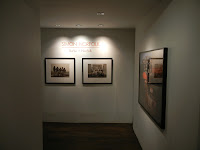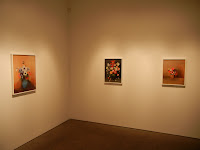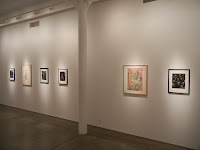Comments/Context: I'm not sure whether Terry Richardson is better known for his ubiquitous fashion and celebrity photographs or for his infamously inappropriate behavior in taking some of those pictures. Either way, his most recent show asks the viewer to step beyond these overly obvious characterizations and to examine his photographs of his parents in the context of art.
.
.
The premise and organization of this exhibit is unpretentiously simple: take images of his two parents (who were separated early in his life), and intermix them on the walls, with images of his childhood (school portraits with bushy hair and the like) strewn across the floor. His flash-lit, snapshot aesthetic makes for pictures that seem casual and honest, with an immediacy that is sometimes too close for comfort. His mother is captured as an ecstatic free spirit, constantly laughing or mischievously smiling, smoking or giving the camera the finger in eccentric joy. His father tends toward more gloomy, downbeat moods, often staring directly into the camera, exposing his scarred wrists, or offering a posed but seemingly unadorned look into his soul. His all capitals marker scrawls all over the house and in notebooks range from the upsetting (HARD TO SWALLOW - FEEL LIKE I'M CHOKING) to the dreary (SHIT STILL IN TOILET) to the authentically poignant (I AM VERY PROUD TO BE YOUR DAD). All of the works combine wince-inducing harsh reality with a genuine, personal tenderness that ensures the pictures don't drift into mockery.
.
.
I'm not sure that all of these pictures qualify as great or durable photographs or that many of them are particularly enjoyable to look at, but I give Richardson credit for exposing some raw truth in these images. There are a handful of shots in this bunch that sensitively document the complicated, emotional relationships between a parent and son, and do so with frankness, candor, and quiet affection. In the end, my guess is that these photographs will ultimately function best in book form, where deliberate sequencing will allow for a richer, intermingled family narrative whose power will stretch beyond any one individual image. These are tough, sometimes gritty pictures, that simultaneously drive you to look away, but pull you back in with their unsightly, unadorned closeness.
.
Collector's POV: The works in the show are priced between $2500 and $5000, based on size. Richardson's photographs have been intermittently available in the secondary markets in recent years, with prices ranging from $1000 to $16000. That said, given the small number of lots that have come up for sale at auction, gallery retail is still likely the best option for collectors interested in following up..
Rating: * (one star) GOOD (rating system described here)
Transit Hub:
Terry Richardson, Mom & DadThrough December 4th
Half Gallery
208 Forsyth Street
New York, NY 10002
















































